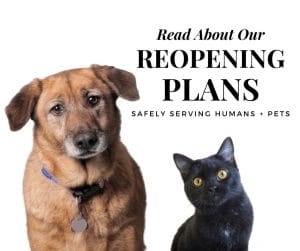So often the word marketing conjures an image of Mad Men-style brainstorms and campaigns – all polish and slickness and sales. But for animal shelters and rescues, marketing is so much more. It’s the way we reach new adopters; connect with those in need of our services; garner support for humane laws and influence community perceptions; and of course, find new fosters, volunteers, and donors. In short, it’s one of the most important lifesaving tools in our toolbox.

And now, more than ever, the way that we work to keep the community informed is critical to our continued success. In a time when, even as some of us begin to “re-open”, our operations have changed in vast ways, we need to make sure that our constituents understand how to find us, interact with us, and help us. We’ve worked so hard over the years to train the public to follow certain protocols and largely that focus has been on coming to our facilities. Now it’s time to retrain them to interact in less traditional but just as important ways.
COVID-19 has been a moving target in every way possible, and it’s easy to feel like every week there is different information and new protocols to follow. And that’s just how we feel internally. Imagine being a member of the public who may have never adopted before or needed your help before. It’s a lot to take in on top of all the other messages and changes we’re all experiencing.
With that in mind, here are some quick tips on keeping the community informed as we continue to move forward!
- Don’t hesitate: Changes to hours, operations, and protocols for how to interact with your services should be communicated swiftly (after internal communications have been finalized, of course). Don’t wait until there’s already confusion, be proactive about getting the word out.

- Get comfortable repeating yourself: We get tired of hearing ourselves say the same things over and over, but when our primary methods of communicating are digital (think: email newsletters, videos, social media, etc.), where there’s lots of “noise” and competition to be heard, we’ll likely need to get the word out again and again. Find ways to keep reminding folks about changes and updates by varying the ways you tell the same story (use photos, video, go live, send a newsletter, write a press release). For example: Hawaii Island Humane posts their COVID-19 adoption and foster protocol every time they share an available pet. It helps to habituate adopters to their new way of doing business.
- Be patient, kind, and responsive: We’re all feeling the stress of this unique moment in different ways. The best way for us to show leadership and poise in this moment is to respond consistently, with compassion, and with a reserve of patience (as always! But it’s worth reminding ourselves when we have so much on our plates as well.)
- Find the balance: There’s no single “right” way to reach your community right now. Balance more serious calls for help and action, and straightforward appeals, with lighthearted content that gives people the comfort and humor that only pets can offer. The magic is in sharing a little bit of everything.
Need more tools or inspiration to keep your community up-to-date and engaged right now?




